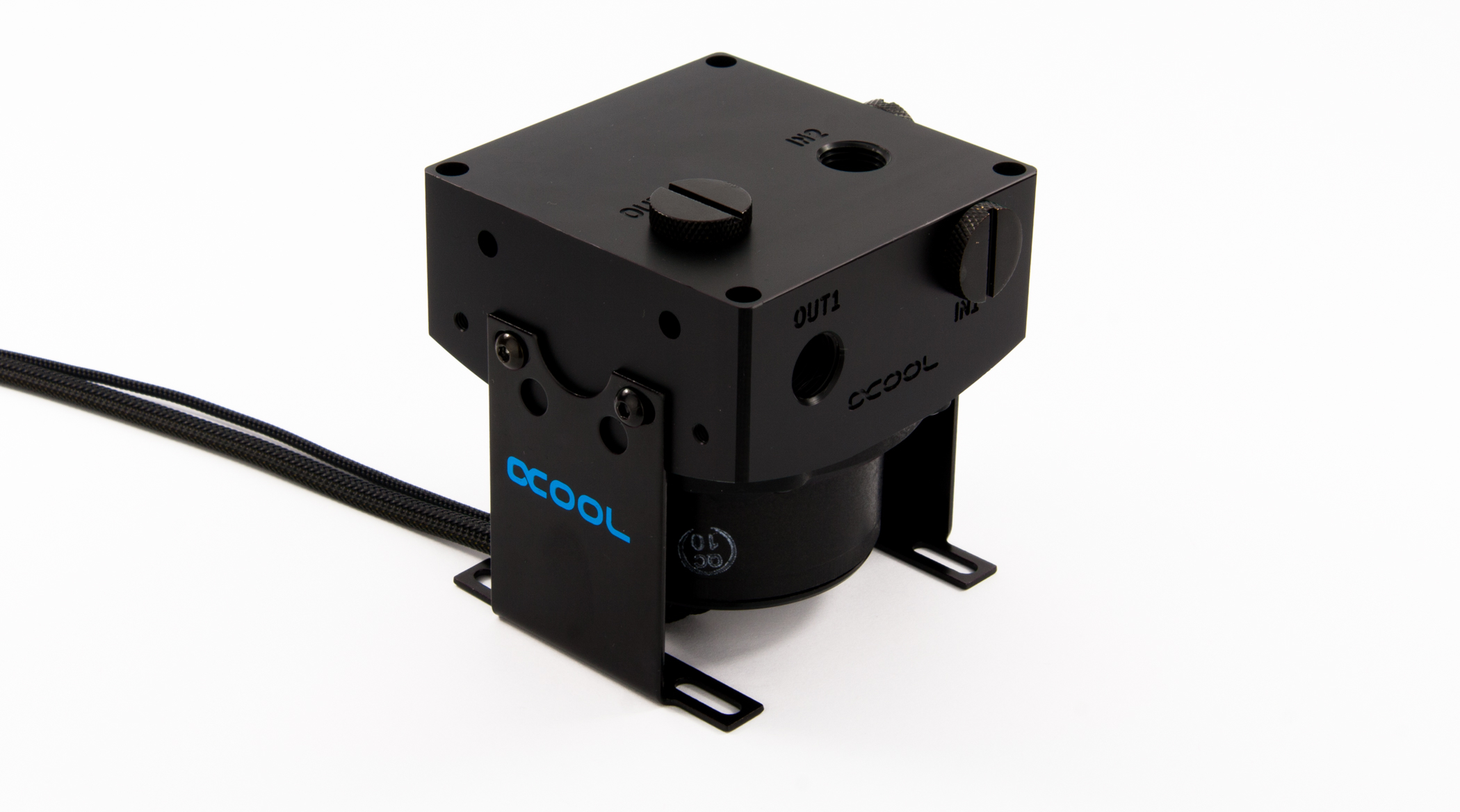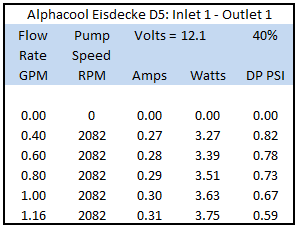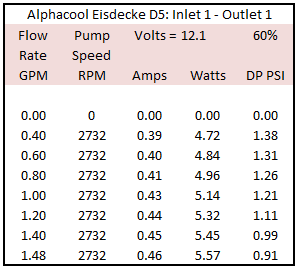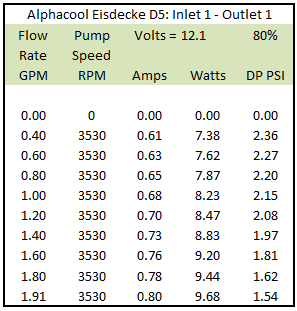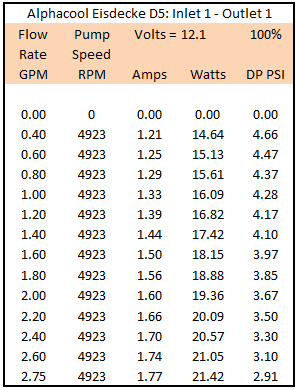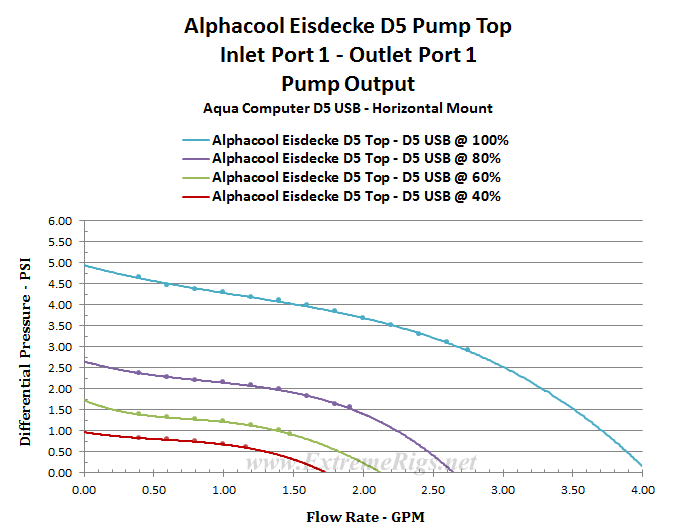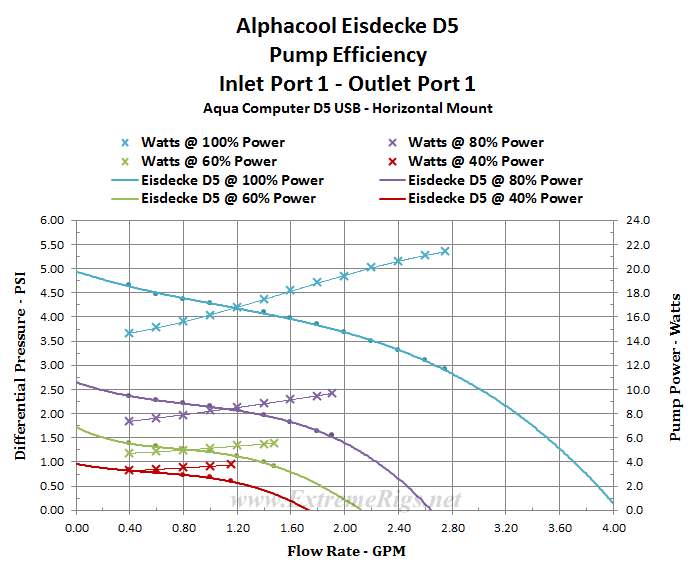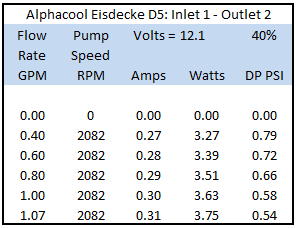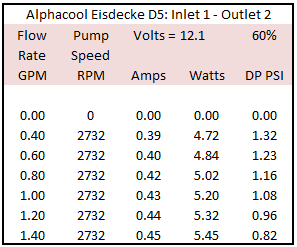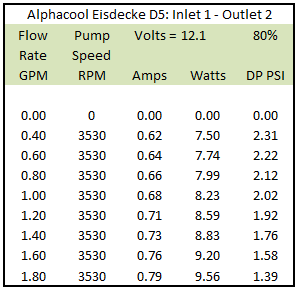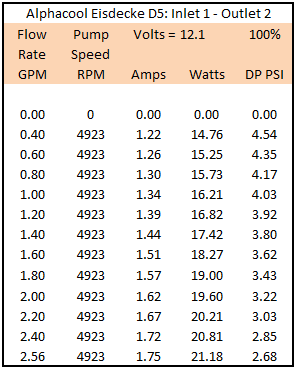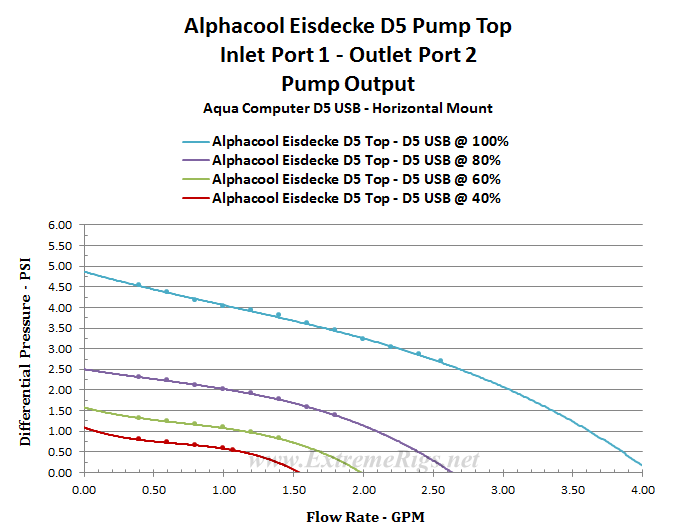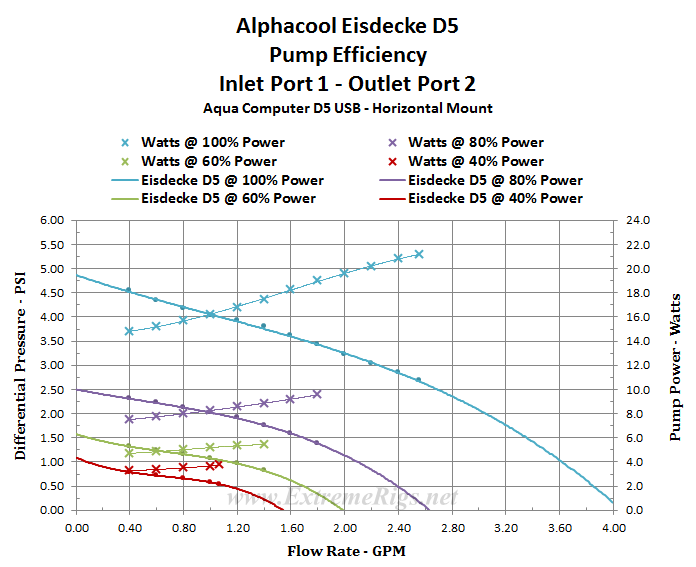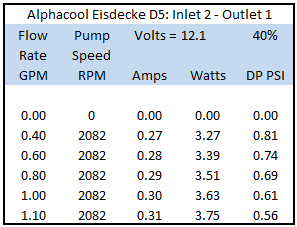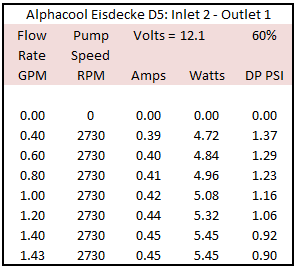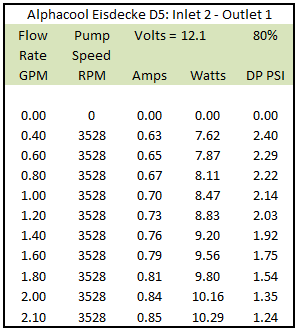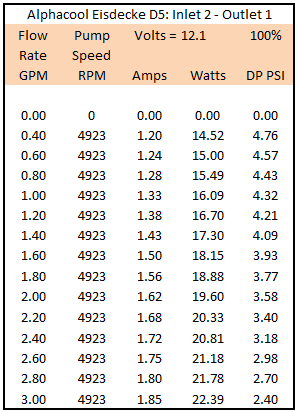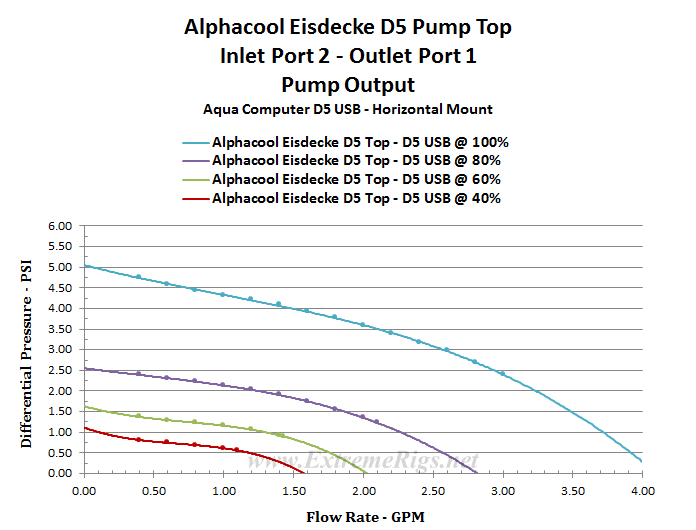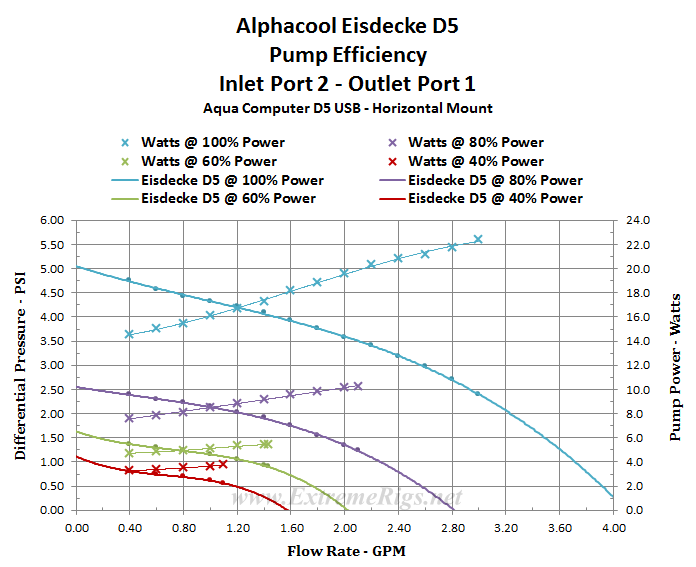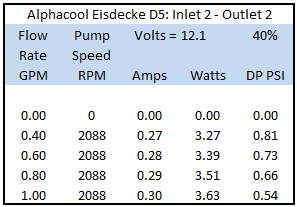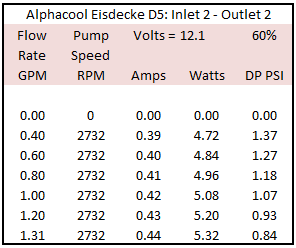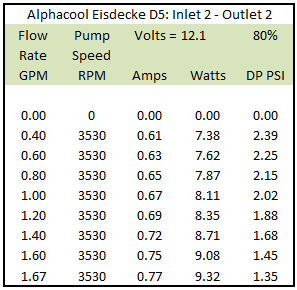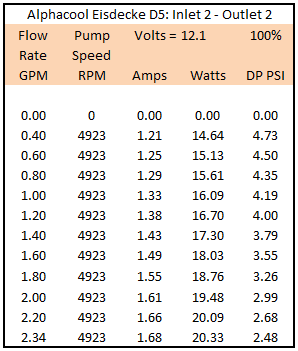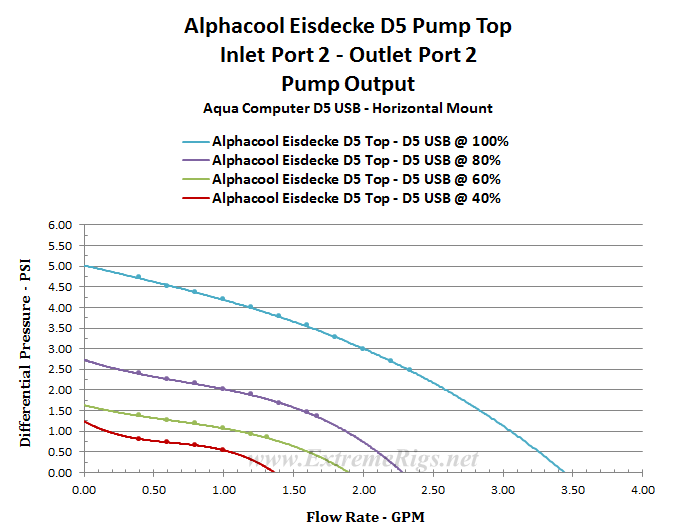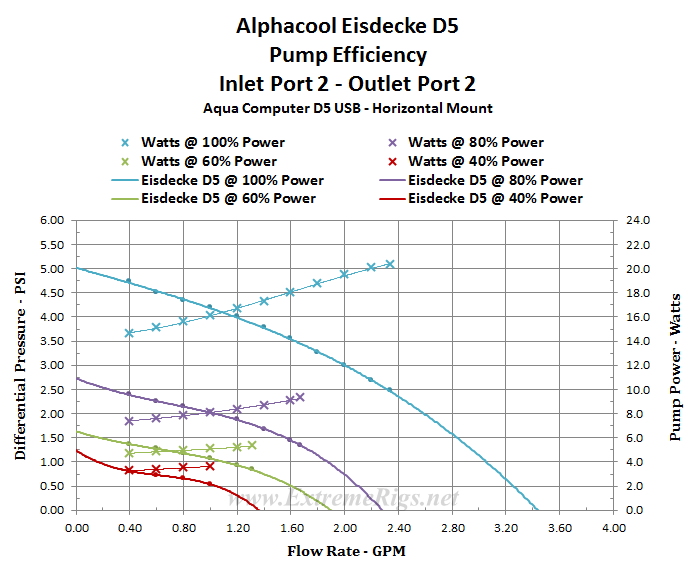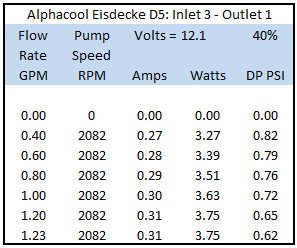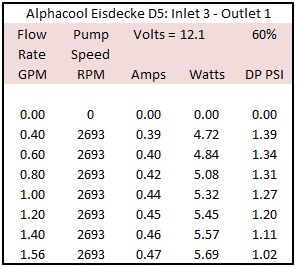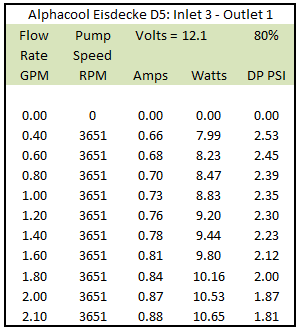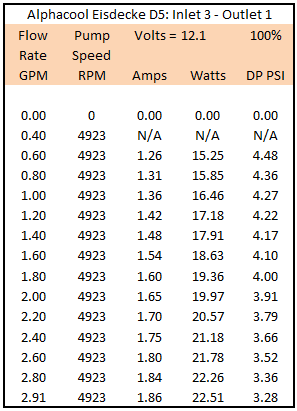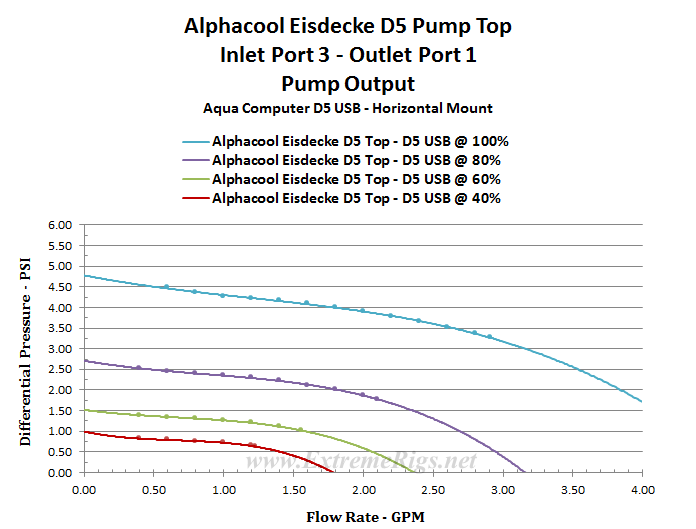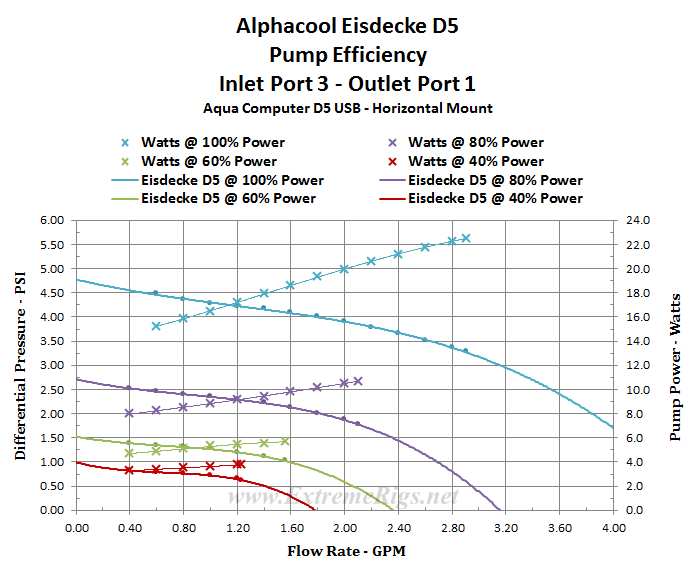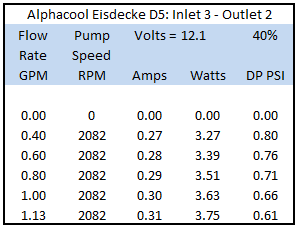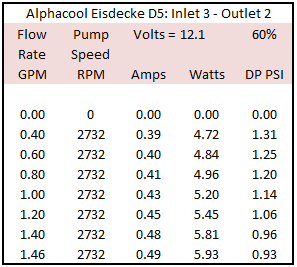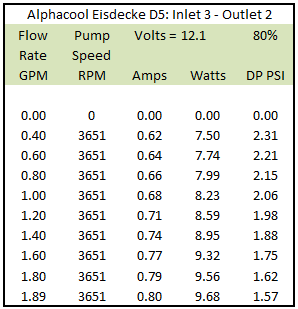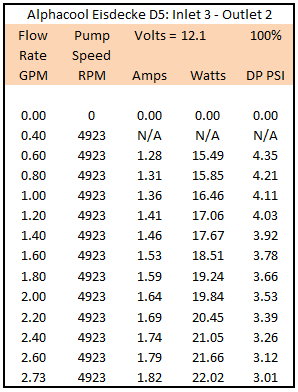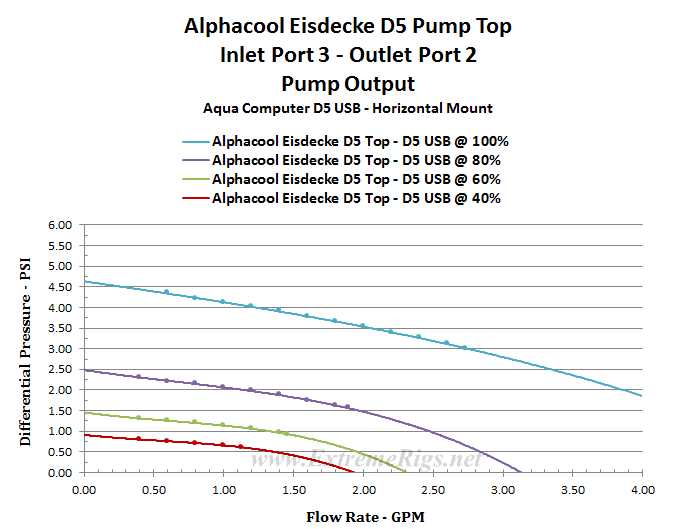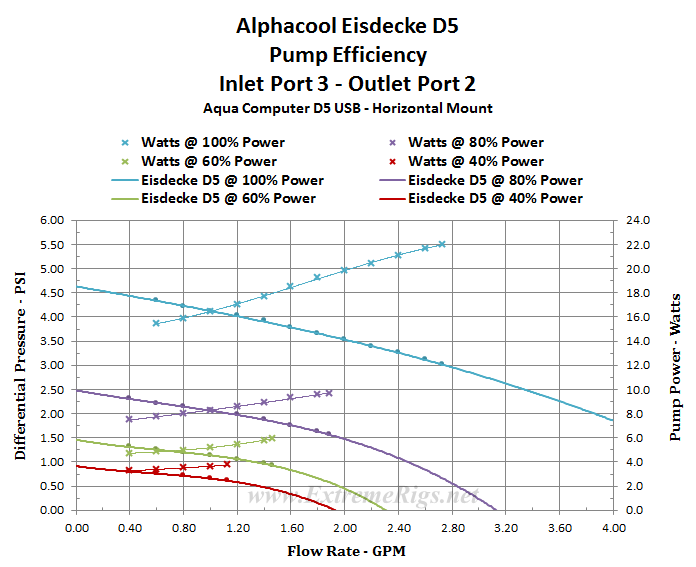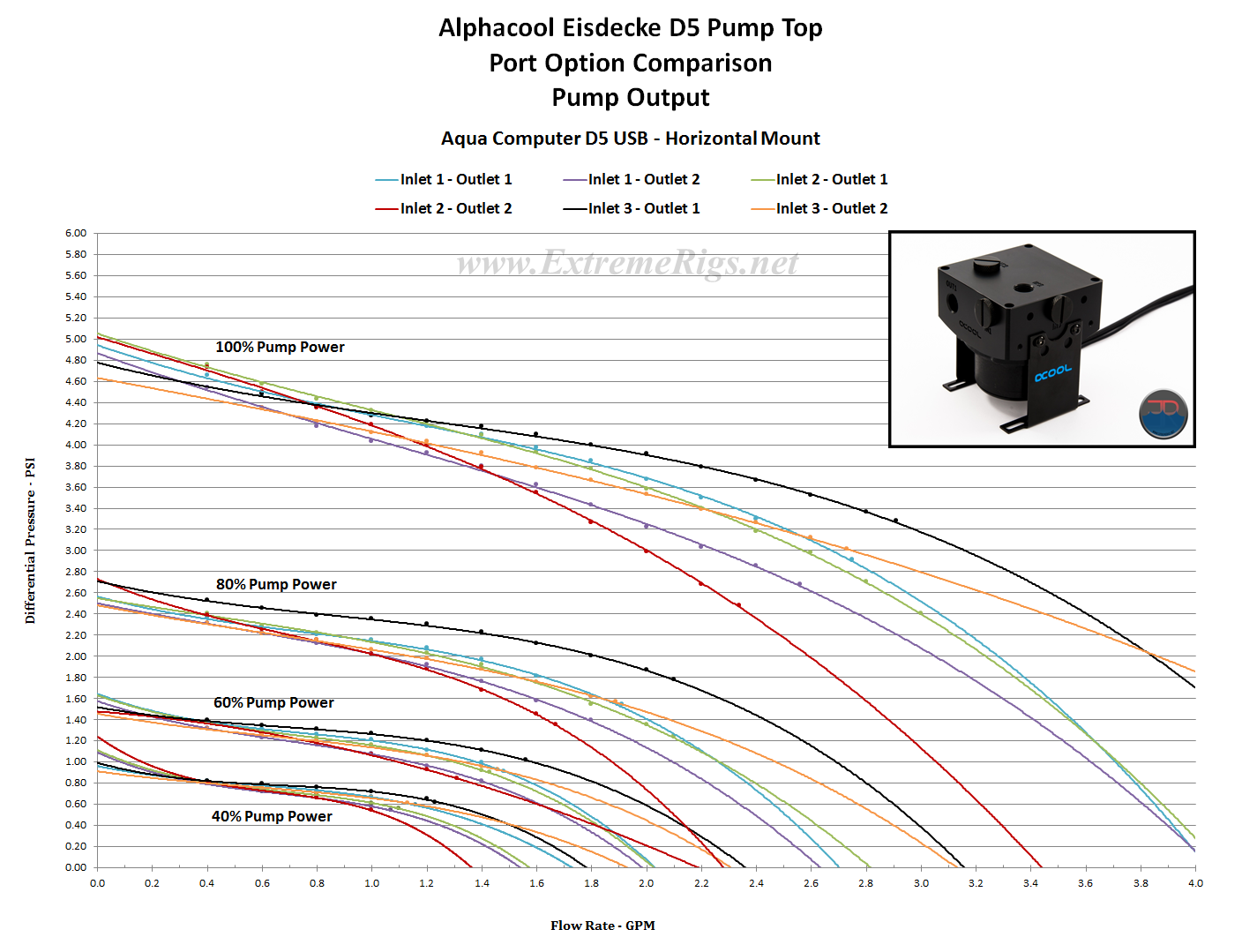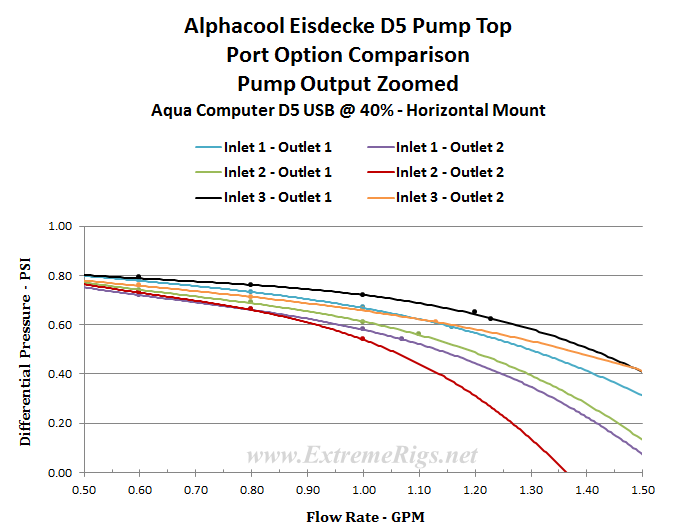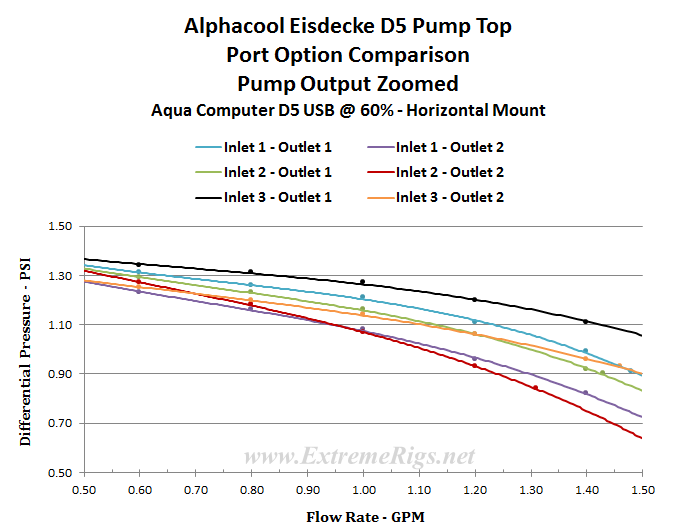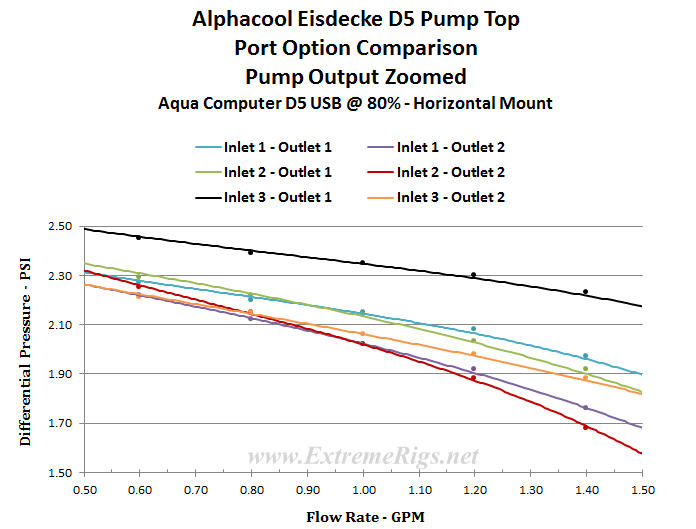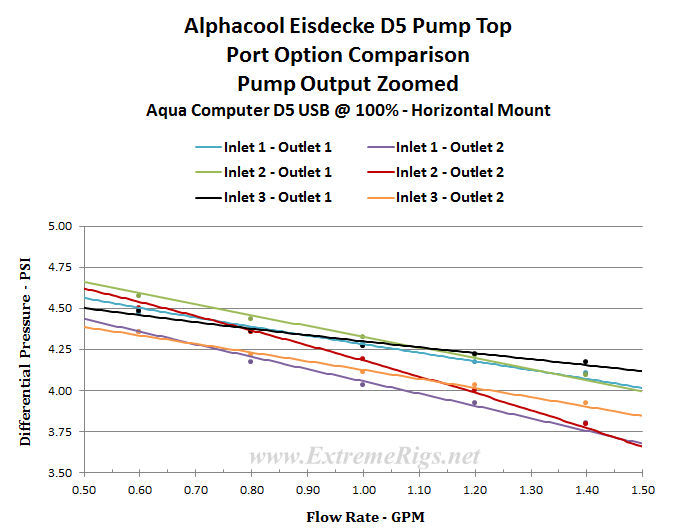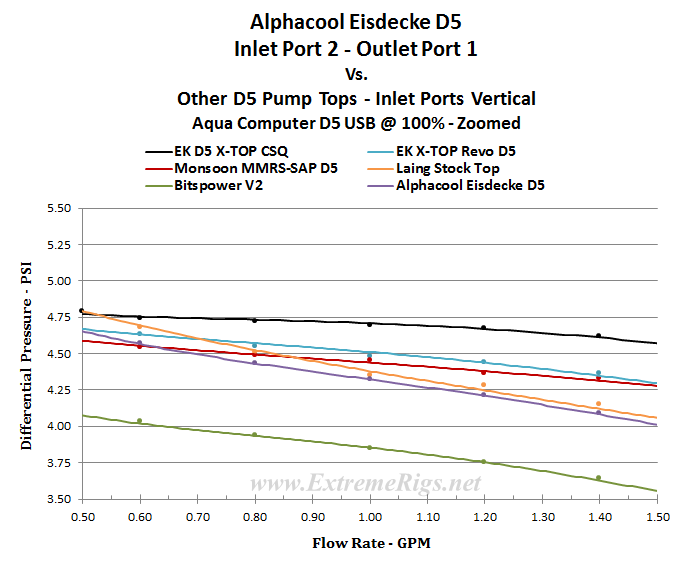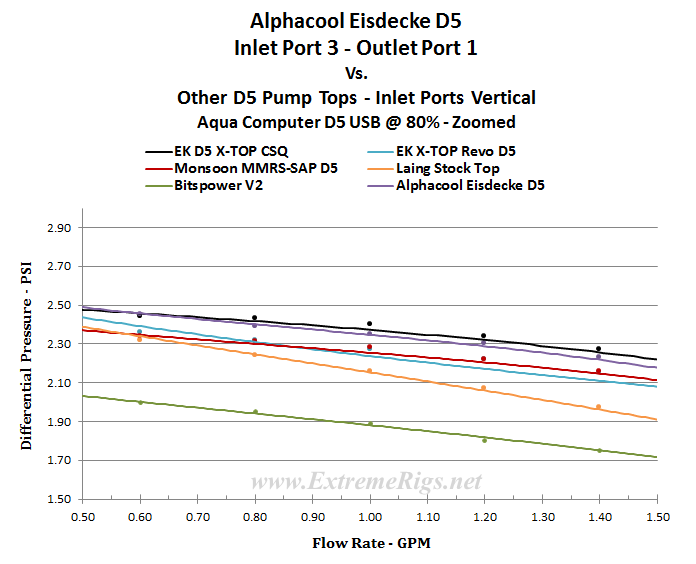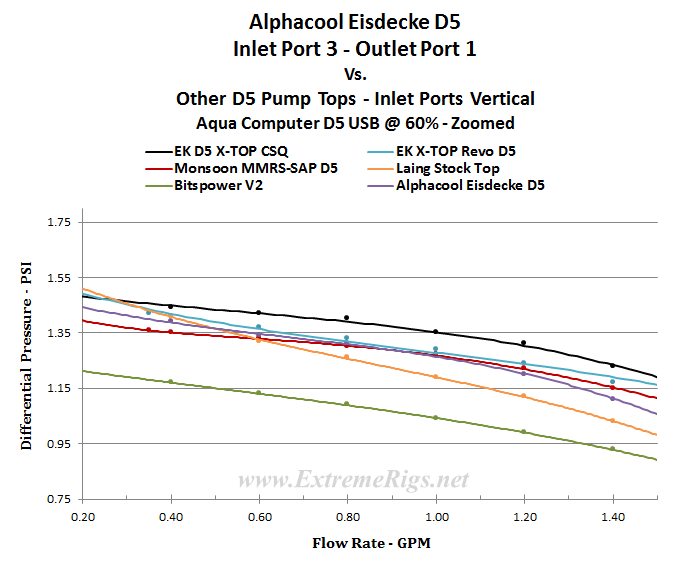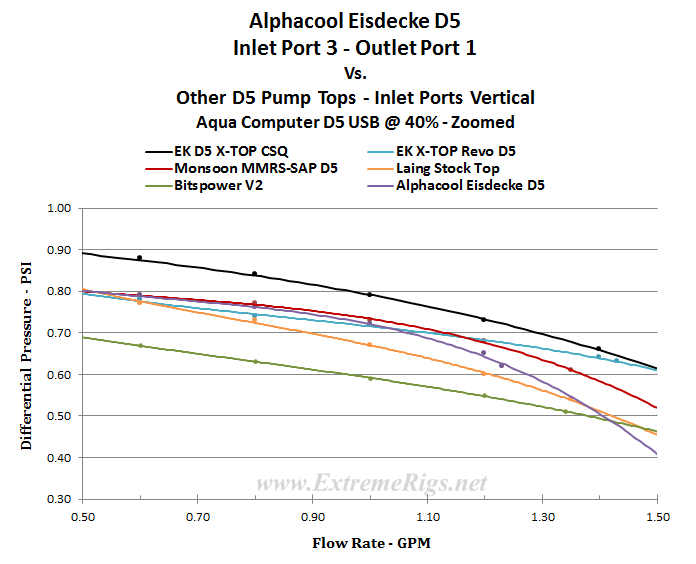We carried out extensive testing on the Eisdecke D5 pump top, more than any we’ve ever done because of all the port options. With it’s 3 inlet ports and 2 outlet ports there are 6 possible port combinations to test. Each of the 6 port combinations had 4 pump power test tests conducted making a total of 24 flow/pressure tests that were performed. We could have easily doubled that by repeating every test with the pump top vertically orientated, but that would really have taken so much extra time. All the results shown are from the tests conducted with the pump top orientated horizontally (pump under the top).
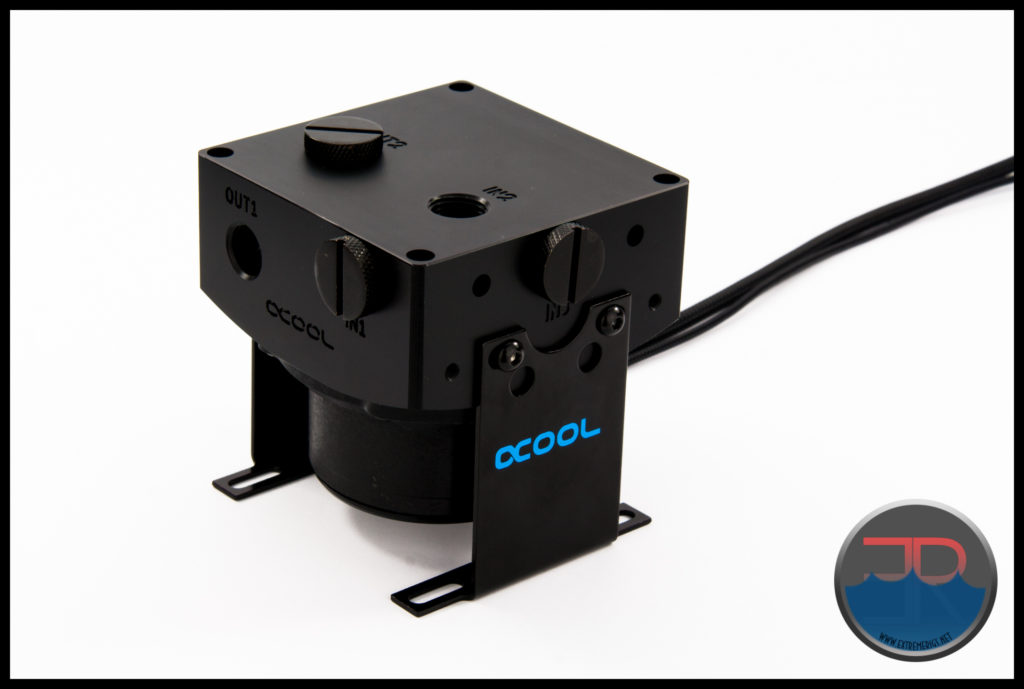
Essentially these tests measure the flow rate and pressure output of the pump. By comparing the results of the same pump fitted to different tops we can make an assessment of the top’s performance by comparing it’s results to others.
To test pump tops we use a flow meter and a differential manometer and vary restriction by adjusting a brass gate valve. We adjust the gate valve to give different flow points and measure the pressure “gain” across the pump using the differential manometer. To better understand how to read these plots check out this guide.
Again a trusty Aqua Computer D5 USB pump was used so any previous pump top tests results can be used for comparisons.
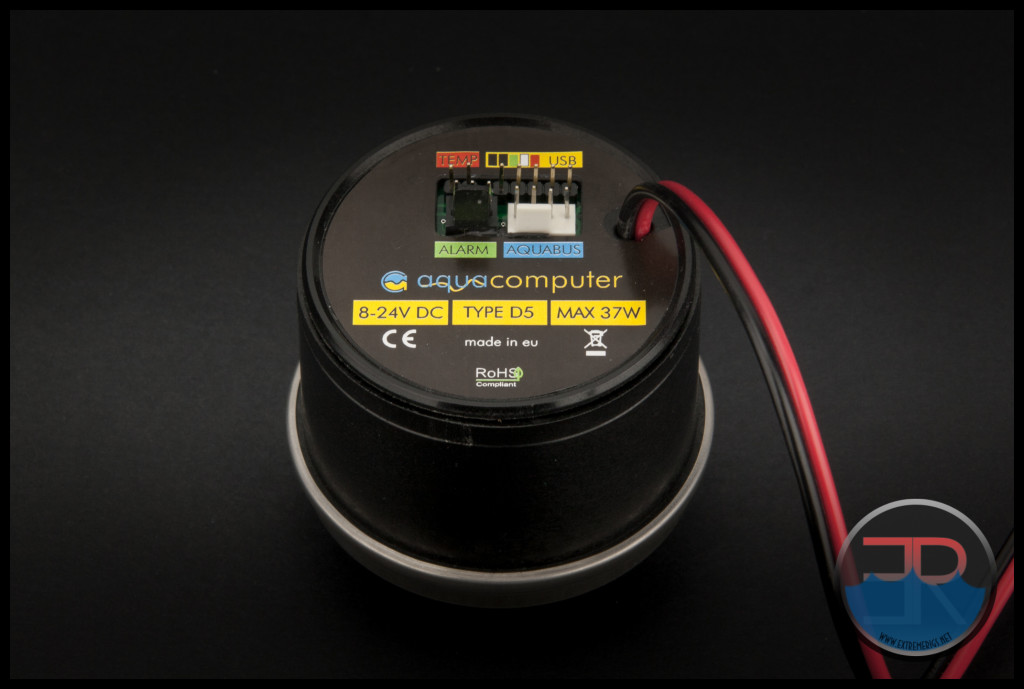 This version of the D5 pump is an electronically controlled Vario which is able to have the power adjusted via Aqua Computer’s Aquasuite software. The USB connection was hooked up to a laptop for varying the power to the pump. Minimum power level is 25% and maximum is 100% and keeping in line with recent testing, 4 power levels were chosen to test at: 40%, 60%, 80% and 100%.
This version of the D5 pump is an electronically controlled Vario which is able to have the power adjusted via Aqua Computer’s Aquasuite software. The USB connection was hooked up to a laptop for varying the power to the pump. Minimum power level is 25% and maximum is 100% and keeping in line with recent testing, 4 power levels were chosen to test at: 40%, 60%, 80% and 100%.
We have a lot of data from the Eisdecke testing, so we’ll just display the resulting plots which we’ll comment on as required. The raw data we’ll spoiler so it is still available for those who wish to analyze things further.
Let’s start off with Inlet 1 and Outlet 1 to see how the Eisdecke D5 performed and carry on in numerical order of the ports.
Inlet 1 – Outlet 1
The first plot for each port combination shall be displayed like the one below and is derived from the data which is spoilered above. This plot shows each of the Differential Pressure data points collected during testing at specific flow rates. This tells us the output for the pump / pump top combination in PSI @ GPM for each of the power settings we tested at. Some extrapolation has been added to continue the plotted curves.
Pump Output: Inlet 1 – Outlet 1
Next we’ll overlay the pump power consumed at each data point. The cross over point between Pump Efficiency and Pump Output is of no significance but the plot does show how much power the pump is using to achieve each PSI and GPM data point. To make the “mental” matching of data points easier we’ve added vertical axis grid lines to these plots.
Pump Efficiency: Inlet 1 – Outlet 1
Inlet 1 – Outlet 2
Pump Output: Inlet 1 – Outlet 2
Pump Efficiency: Inlet 1 – Outlet 2
Inlet 2 – Outlet 1
Pump Output: Inlet 2 – Outlet 1
Pump Efficiency: Inlet 2 – Outlet 1
Inlet 2 – Outlet 2
Pump Output: Inlet 2 – Outlet 2
Pump Efficiency: Inlet 2 – Outlet 2
Inlet 3 – Outlet 1
Pump Output: Inlet 3 – Outlet 1
Pump Efficiency: Inlet 3 – Outlet 1
Inlet 3 – Outlet 2
Pump Output: Inlet 3 – Outlet 2
Pump Efficiency: Inlet 3 – Outlet 2
Pump Output Port Comparison.
Now we have seen each port combination individually it’s time we had a look at which port combination has the best output at each power setting.
The above plot obviously is a bit hard to decipher, so we’ve split each power level onto it’s own plot and then zoomed in on the usable zone for each. This will tell us which port combination offers the best performance at each power level.
We understand that the majority of users will have the port options they plumb-up dictated by the location of the pump/top assembly. For those who have the freedom to choose, there are obvious differences in pump output at different power levels between the port options. For example the port combination with the best output on 100% power at 0.8 GPM is not the best port combo if running the pump at 80% power.
Let’s start with 40% power and work our way up.
40% Power – Pump Output Port Comparison.
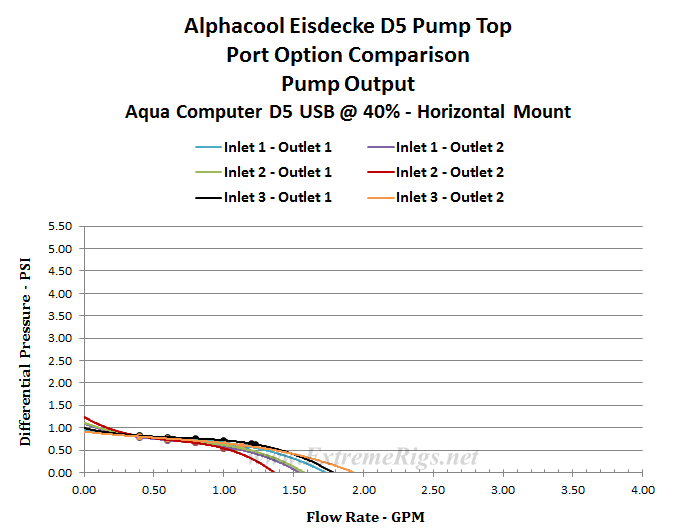 While 0.2 PSI doesn’t seem like much of a difference (at 1.0 GPM) the reality is that at this power level there is around 25% variance which is huge. We wonder if we’ll see the same amount of variation as the pump power is increased. This setting might just be usable for a CPU Only loop with a low restriction radiator.
While 0.2 PSI doesn’t seem like much of a difference (at 1.0 GPM) the reality is that at this power level there is around 25% variance which is huge. We wonder if we’ll see the same amount of variation as the pump power is increased. This setting might just be usable for a CPU Only loop with a low restriction radiator.
Inlet 3 – Outlet 1 has the best performance at all flow rates at this pump speed.
60% Power – Pump Output Port Comparison.
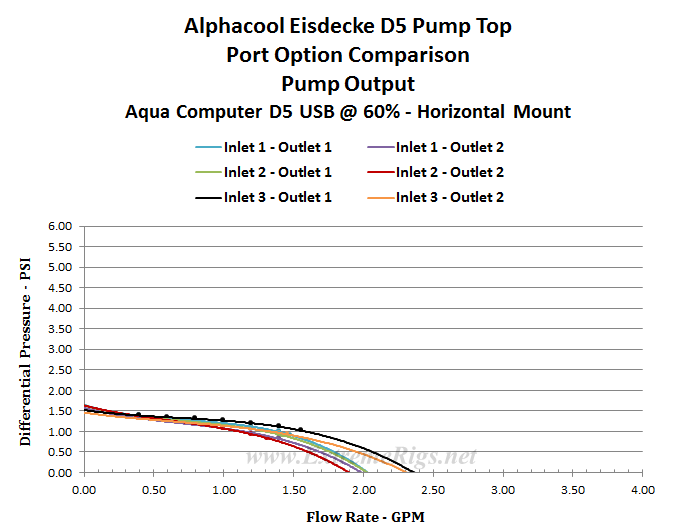 Inlet 3 – Outlet 1 again has the best performance, but now we see that the three Outlet Port 1 combinations lead the way. While the percentage difference at 1.0 GPM has dropped, the pressure difference remains at ~0.2 PSI.
Inlet 3 – Outlet 1 again has the best performance, but now we see that the three Outlet Port 1 combinations lead the way. While the percentage difference at 1.0 GPM has dropped, the pressure difference remains at ~0.2 PSI.
80% Power – Pump Output Port Comparison.
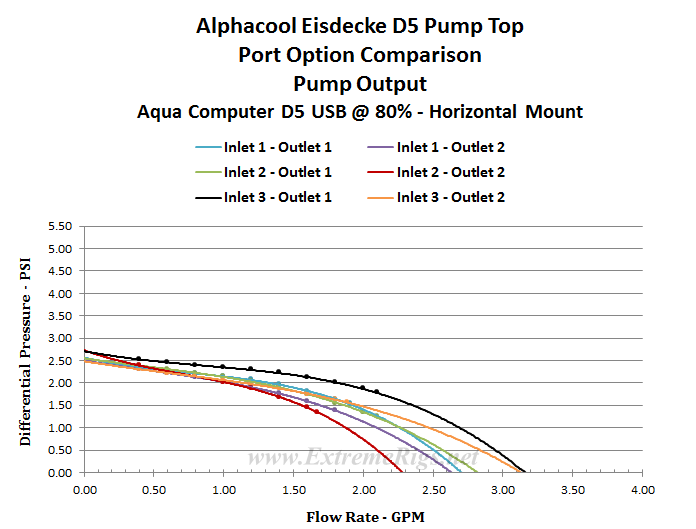 Inlet 3 – Outlet 1 has a clear performance advantage at 80% pump power and the gap between best and worst at 1.0 GPM is now nudging 0.4 PSI. To put that onto perspective, 0.4 PSI is the roughly equivalent to the restriction level of 2 low restriction 360mm radiators.
Inlet 3 – Outlet 1 has a clear performance advantage at 80% pump power and the gap between best and worst at 1.0 GPM is now nudging 0.4 PSI. To put that onto perspective, 0.4 PSI is the roughly equivalent to the restriction level of 2 low restriction 360mm radiators.
100% Power – Pump Output Port Comparison.
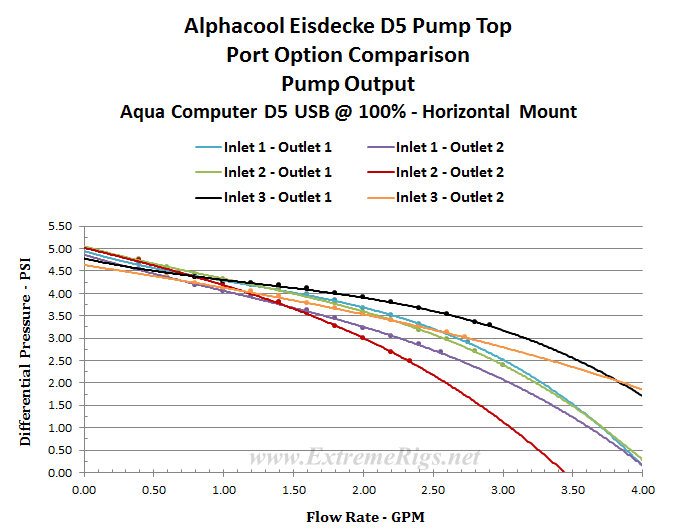 Just when it looked like the Inlet 3 – Outlet 1 port combo was going to be a clear winner at all flow rates for each power level the Inlet 2 – Outlet 1 port combo just takes the lead in our usable zone.
Just when it looked like the Inlet 3 – Outlet 1 port combo was going to be a clear winner at all flow rates for each power level the Inlet 2 – Outlet 1 port combo just takes the lead in our usable zone.
Eisdecke D5 Vs. The Competition.
Now we know how the Eisdecke D5 performs against itself in the different port configurations, how does it perform against other D5 tops which we have tested recently. We’ve given the Eisdecke D5 the advantage in these comparisons by using the best pump output port combination (as we just determined in out port comparisons), while the competition’s data is exclusively derived from vertical inlet port testing. All tops (including the Eisdecke) were orientated horizontally; i.e. with the pump under the tops.
This time lets start with 100% power and work our way down.
Eisdecke D5 Pump Top Vs. Competition at 100% Pump Power.
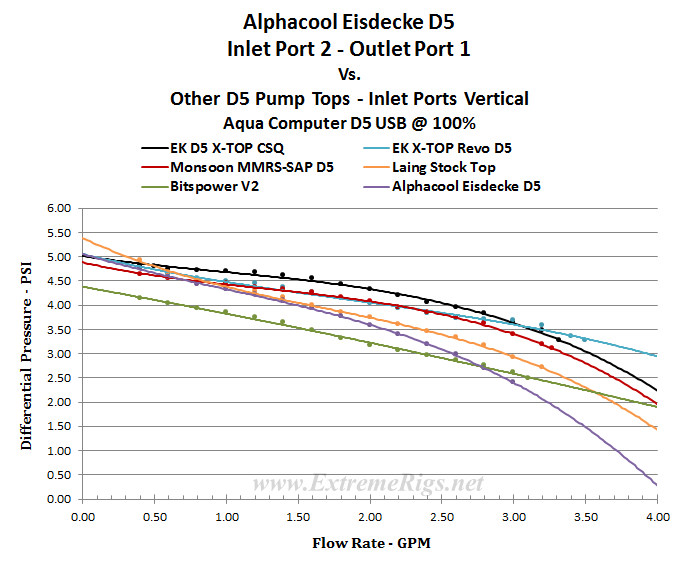 For the 100% comparison we used the Eisdecke D5’s Inlet 2 – Outlet 1 data because this port combination had the best output in the usable zone. Using the best port combo option, the Eisdecke was at the rear of the bunched up mid-pack. In fact it’s output was weaker than the Laing D5 stock top at all flow rates, but it was able to beat out the Bitspower V2 in the usable flow rate zone.
For the 100% comparison we used the Eisdecke D5’s Inlet 2 – Outlet 1 data because this port combination had the best output in the usable zone. Using the best port combo option, the Eisdecke was at the rear of the bunched up mid-pack. In fact it’s output was weaker than the Laing D5 stock top at all flow rates, but it was able to beat out the Bitspower V2 in the usable flow rate zone.
Eisdecke D5 Pump Top Vs. Competition at 80% Pump Power.
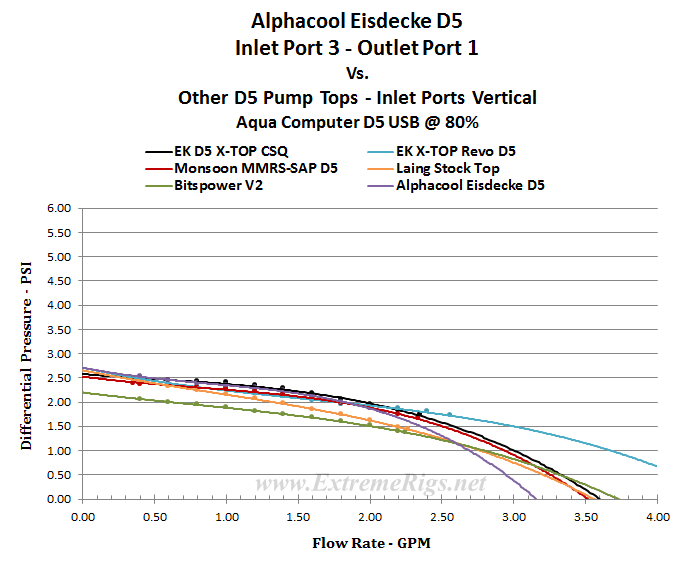 At 80% power and using Inlet Port 3 – Outlet Port 1, the Eisdecke D5 top has a much better comparison result and is within a whisker of the EK CSQ top which has been the D5 pump top dominator since it was released. This obviously is a great results for the Eisdecke D5.
At 80% power and using Inlet Port 3 – Outlet Port 1, the Eisdecke D5 top has a much better comparison result and is within a whisker of the EK CSQ top which has been the D5 pump top dominator since it was released. This obviously is a great results for the Eisdecke D5.
Eisdecke D5 Pump Top Vs. Competition at 60% Pump Power.
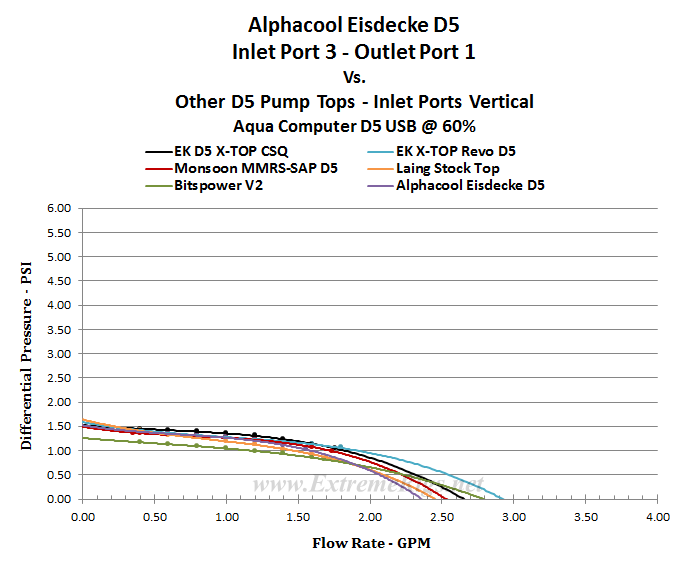 When we analyze the 60% power comparisons, we see the Eisdecke has dropped back to the mid-pack, but is clear of the stock Laing top in our usable zone.
When we analyze the 60% power comparisons, we see the Eisdecke has dropped back to the mid-pack, but is clear of the stock Laing top in our usable zone.
Eisdecke D5 Pump Top Vs. Competition at 40% Pump Power.
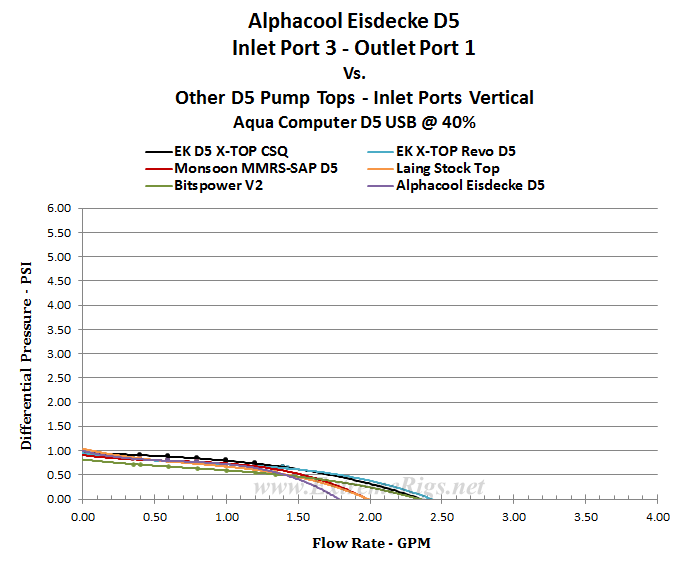 At 40% power the Eisdecke D5 is again mid-pack using it best port comparison. Here we see the best output at the lower flow rates (more restriction), but it has a steeper decline in pressure output than the competition as restriction is reduced.
At 40% power the Eisdecke D5 is again mid-pack using it best port comparison. Here we see the best output at the lower flow rates (more restriction), but it has a steeper decline in pressure output than the competition as restriction is reduced.
Finally for our Eisdecke D5 performance comparisons against other D5 tops, let’s take away the advantage the Eisdecke was given in the previous plots and look solely at the data for all pumps using vertical inlet ports and horizontal outlet ports. For the Eisdecke D5 that means using Inlet 2 and Outlet 1 set up with the provided brackets. Again all pump tops were horizontally orientated with the pumps underneath the tops.
This time we’ll only look at the four data points in the usable zone and with the Differential Pressure readings displayed. By doing so we can see what the PSI output for each pump top is at each flow rate of the power setting. These numbers are the key to making a very good estimate of your system flow rate prior to assembling or even purchasing anything (provided you can get pressure drop readings for all your components).
First are the 100% Power Comparisons:
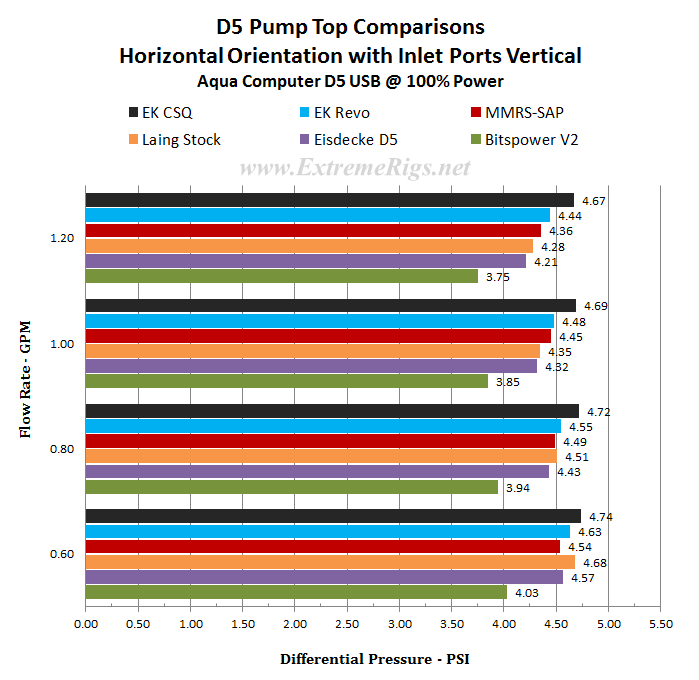 At 100% power the Eisdecke D5 top is marginally behind the Laing stock top for performance. Other current generation D5 tops have a slight performance advantage at the higher flow rates in our usable zone which would equate to around about the pressure drop of one low restriction 360mm radiator.
At 100% power the Eisdecke D5 top is marginally behind the Laing stock top for performance. Other current generation D5 tops have a slight performance advantage at the higher flow rates in our usable zone which would equate to around about the pressure drop of one low restriction 360mm radiator.
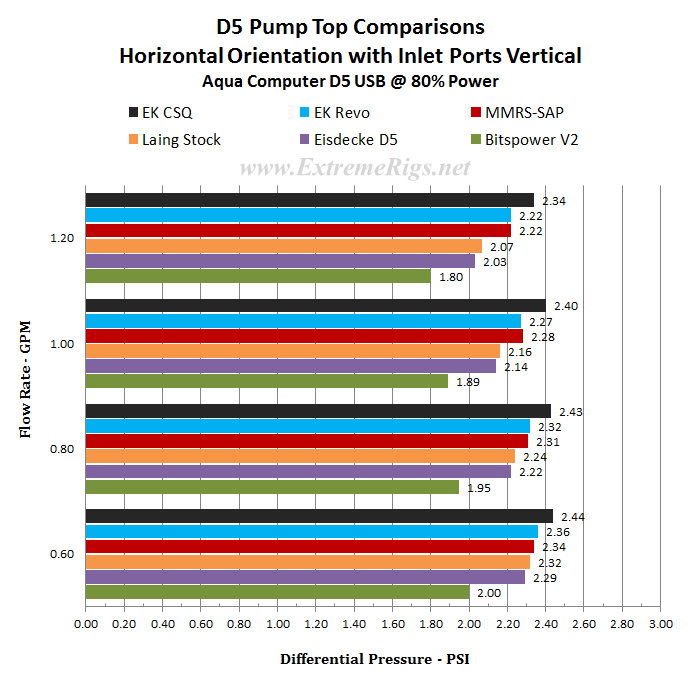 At 80% power level we again see the Laing stock D5 top just getting the better of the Eisdecke D5 top. The comparative performance of the Eisdecke improves as the flow rate is reduced (more restriction).
At 80% power level we again see the Laing stock D5 top just getting the better of the Eisdecke D5 top. The comparative performance of the Eisdecke improves as the flow rate is reduced (more restriction).
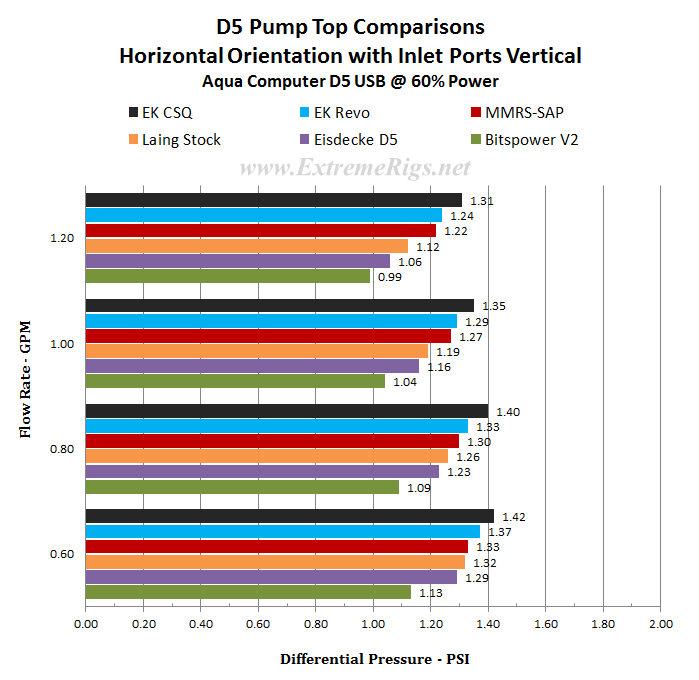 With 60% power to the pump we see a similar pattern in comparative performance as we saw previously on the 80% power plot.
With 60% power to the pump we see a similar pattern in comparative performance as we saw previously on the 80% power plot.
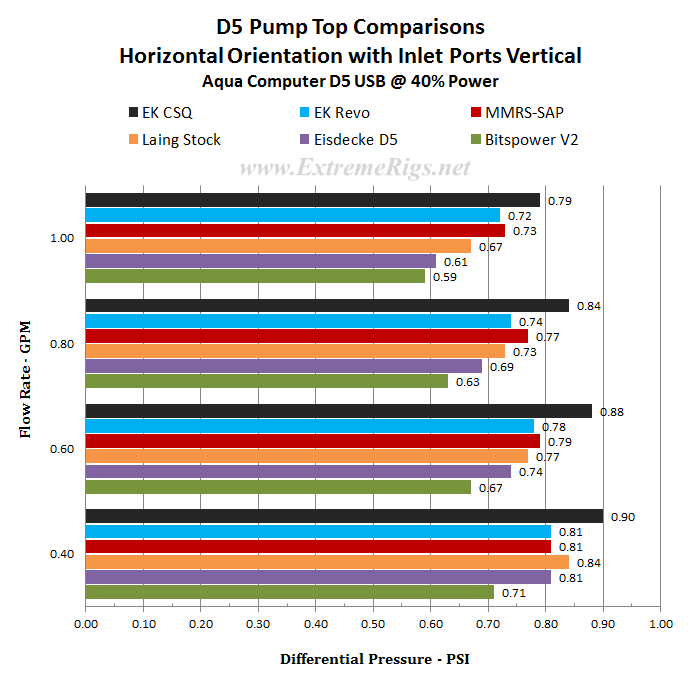 At 40% power the Eisdecke D5 is not as strong in the higher flow rates of our usable zone, but gains on the competition as the flow rate drops when more restriction is applied.
At 40% power the Eisdecke D5 is not as strong in the higher flow rates of our usable zone, but gains on the competition as the flow rate drops when more restriction is applied.
The last four plots tell us that when the Eisdecke D5 Top is set up with the default installation orientation using the vertical inlet port and horizontal outlet port it has weaker performance than the stock Laing top at every data point. We realize that the Eisdecke offers port options that the Laing stock top does not, but the Eisdecke is an aftermarket top and we believe should offer a performance gain as well as the additional port options. Having said that, we acknowledge that the performance difference is small and that other port option combinations of the Eisdecke do actually have better performance than the stock top.
The Eisdecke had the best performance output of any current generation D5 top at one data point using one specific set of ports, but for the most part is has performance that was average at best.
Next up – Summary.







